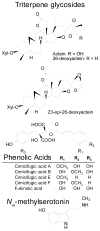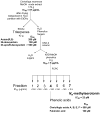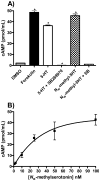In vitro serotonergic activity of black cohosh and identification of N(omega)-methylserotonin as a potential active constituent
- PMID: 19049296
- PMCID: PMC3684073
- DOI: 10.1021/jf803298z
In vitro serotonergic activity of black cohosh and identification of N(omega)-methylserotonin as a potential active constituent
Abstract
Cimicifuga racemosa (L.) Nutt. (syn. Actaea racemosa L., black cohosh) is used to relieve menopausal hot flashes, although clinical studies have provided conflicting data, and the active constituent(s) and mechanism(s) of action remain unknown. Because serotonergic receptors and transporters are involved with thermoregulation, black cohosh and its phytoconstituents were evaluated for serotonergic activity using 5-HT7 receptor binding, cAMP induction, and serotonin selective re-uptake inhibitor (SSRI) assays. Crude extracts displayed 5-HT7 receptor binding activity and induced cAMP production. Fractionation of the methanol extract led to isolation of phenolic acids and identification of N(omega)-methylserotonin by LC-MS/MS. Cimicifuga triterpenoids and phenolic acids bound weakly to the 5-HT7 receptor with no cAMP or SSRI activity. In contrast, N(omega)-methylserotonin showed 5-HT7 receptor binding (IC50 = 23 pM), induced cAMP (EC50 = 22 nM), and blocked serotonin re-uptake (IC50 = 490 nM). These data suggest N(omega)-methylserotonin may be responsible for the serotonergic activity of black cohosh.
Figures







Similar articles
-
Metabolism of Nω -methylserotonin, a serotonergic constituent of black cohosh (Cimicifuga racemosa, L. (Nutt.)), by human liver microsomes.Biomed Chromatogr. 2014 Dec;28(12):1647-51. doi: 10.1002/bmc.3197. Epub 2014 May 12. Biomed Chromatogr. 2014. PMID: 24817649 Free PMC article.
-
Black cohosh acts as a mixed competitive ligand and partial agonist of the serotonin receptor.J Agric Food Chem. 2003 Sep 10;51(19):5661-70. doi: 10.1021/jf034264r. J Agric Food Chem. 2003. PMID: 12952416
-
On the Biosynthesis of Bioactive Tryptamines in Black Cohosh (Actaea racemosa L.).Plants (Basel). 2025 Jan 20;14(2):292. doi: 10.3390/plants14020292. Plants (Basel). 2025. PMID: 39861645 Free PMC article.
-
Ethnobotany, Phytochemistry, Traditional and Modern Uses of Actaea racemosa L. (Black cohosh): A Review.Adv Exp Med Biol. 2021;1308:403-449. doi: 10.1007/978-3-030-64872-5_24. Adv Exp Med Biol. 2021. PMID: 33861455 Review.
-
[Efficacy and safety of Black cohosh (Actaea/Cimicifuga racemosa) in the treatment of vasomotor symptoms--review of clinical trials].Ginekol Pol. 2008 Apr;79(4):287-96. Ginekol Pol. 2008. PMID: 18592868 Review. Polish.
Cited by
-
Metabolism of Nω -methylserotonin, a serotonergic constituent of black cohosh (Cimicifuga racemosa, L. (Nutt.)), by human liver microsomes.Biomed Chromatogr. 2014 Dec;28(12):1647-51. doi: 10.1002/bmc.3197. Epub 2014 May 12. Biomed Chromatogr. 2014. PMID: 24817649 Free PMC article.
-
Pharmacokinetics of 23-epi-26-deoxyactein in women after oral administration of a standardized extract of black cohosh.Clin Pharmacol Ther. 2010 Feb;87(2):219-25. doi: 10.1038/clpt.2009.251. Epub 2009 Dec 23. Clin Pharmacol Ther. 2010. PMID: 20032972 Free PMC article. Clinical Trial.
-
Black Cohosh: An Uncommon Culprit of Bradycardia in Postmenopausal Women.Cureus. 2024 Mar 11;16(3):e55984. doi: 10.7759/cureus.55984. eCollection 2024 Mar. Cureus. 2024. PMID: 38606233 Free PMC article.
-
Botanicals and Their Bioactive Phytochemicals for Women's Health.Pharmacol Rev. 2016 Oct;68(4):1026-1073. doi: 10.1124/pr.115.010843. Pharmacol Rev. 2016. PMID: 27677719 Free PMC article. Review.
-
Benefits of Black Cohosh (Cimicifuga racemosa) for Women Health: An Up-Close and In-Depth Review.Pharmaceuticals (Basel). 2022 Feb 23;15(3):278. doi: 10.3390/ph15030278. Pharmaceuticals (Basel). 2022. PMID: 35337076 Free PMC article. Review.
References
-
- Mahady GB. Is black cohosh estrogenic? Nutr Rev. 2003;61:183–186. - PubMed
-
- Carpenter JS. State of the science: hot flashes and cancer. Part 2: management and future directions. Oncol Nurs Forum. 2005;32:969–978. - PubMed
-
- Rossouw JE, Anderson GL, Prentice RL, LaCroix AZ, Kooperberg C, Stefanick ML, Jackson RD, Beresford SA, Howard BV, Johnson KC, Kotchen JM, Ockene J. Risks and benefits of estrogen plus progestin in healthy postmenopausal women: principal results from the Women’s Health Initiative randomized controlled trial. JAMA. 2002;288:321–333. - PubMed
-
- Borrelli F, Ernst E. Black cohosh (Cimicifuga racemosa) for menopausal symptoms: a systematic review of its efficacy. Pharmacol Res. 2008;58:8–14. - PubMed
-
- Tesch BJ. Herbs commonly used by women: An evidence-based review. Am J Obstet Gynecol. 2003;188:S44–S55. - PubMed
Publication types
MeSH terms
Substances
Grants and funding
LinkOut - more resources
Full Text Sources
Other Literature Sources
Miscellaneous

